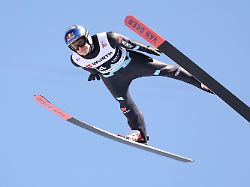Former national coach sounds the alarm
Germany’s ski jumpers are threatened with the Finnish fate
March 20, 2024, 7:18 p.m
German ski jumpers are still world class, but new super eagles like Andreas Wellinger are hardly in sight. There is a risk of a crash after the 2026 Olympic Games. Former national coach Schuster sounds the alarm: “Even the big ski jumping nations can run out of resources.”
Karl Geiger will be 33 years old, Markus Eisenbichler almost 35, Pius Paschke almost 36, even the young professional Andreas Wellinger will be over 30 in 2026: The German ski jumping heroes are getting on in years, and men will probably be seeded at the coming Olympic Games Ages form the core team. After an incredibly successful era, the DSV Eagles are in danger of missing out on change – the lack of elite young talent also alarms former national coach Werner Schuster.
“The sources can also run dry for large ski jumping nations. The Finns were at the top of the world for 40 or 50 years. And now no one has been there for ten years,” said Schuster in the Ski Happens podcast: “You have to be careful about that “The bike stays in motion.” The Austrian, head coach from 2008 to 2019 and has been working in the DSV youth team since last summer, is rightly worried. The team for the 2023/24 season, which now ends with the World Cup final in Planica, consists at its core of the top performers from the Schuster era. And of course these have an expiry date: after 2026 there could be a huge gap.
“How is a young athlete supposed to get in?”
Under Schuster’s successor Stefan Horngacher, only Philipp Raimund (23) of the younger generation made it permanently into the World Cup team. Constantin Schmid (24), who was already established under Schuster, has regressed, while David Siegel (27), who could have become the link, stopped due to injury.
Of course: With dominant personalities like Geiger, Eisenbichler and Wellinger, the German World Cup team was mostly a closed, minimally permeable group – only five, a maximum of six athletes were allowed to start per nation. “How is a young athlete supposed to get in there?” asks Schuster. Not everyone has the patience to wait more than half a decade for their chance in the second-tier Continental Cup, like late starter Paschke.
In Planica there would be an opportunity to slip in, Raimund has ended the season and Schmid is also missing. But in the last weeks of the season there is traditionally ski flying, which the greatest German talent, junior runner-up world champion Adrian Tittel (20), should not be expected to do yet. Instead, two jumpers – Felix Hoffmann (26) and Luca Roth (24) – join the team who are no longer eligible for a great career.
“There are fewer children, there is a lot more on offer”
The current national coach Horngacher is not primarily responsible for the perspective problem, the Austrian cannot look after the youngsters himself – at least not alone: son Amadeus (16) is already jumping for the DSV in the fourth-class Alpine Cup. The structural problems, however, arise earlier.
“There are fewer children, there is a lot more on offer, but also a certain level of convenience,” says Schuster. In his homeland, the talent reservoir seems inexhaustible: the second-class Continental Cup is led by three Austrians, including Schuster’s son Jonas, and the third-class FIS Cup by eight – competition automates the business. In Germany, on the other hand, the few top contenders have to be given maximum support in order to reach World Cup level.
Martin Schmitt sees this as a financial downward spiral. “If the association has to invest a lot more in the top level in order to keep up internationally,” the former top star told Deutschlandfunk, “there isn’t necessarily any more money left over to equip the youngsters accordingly.”
